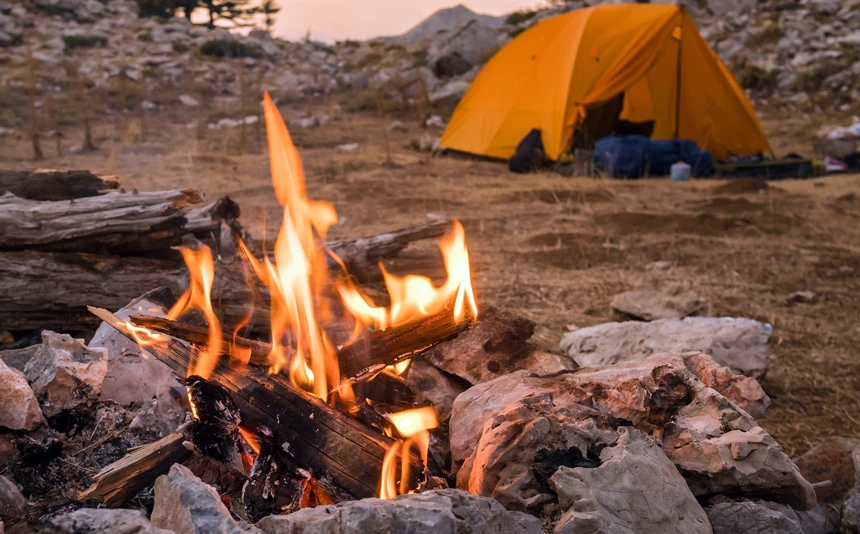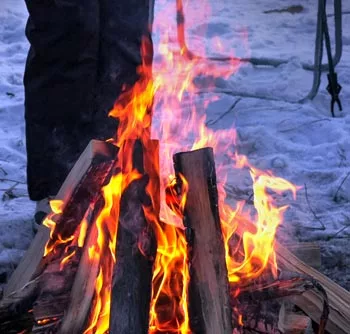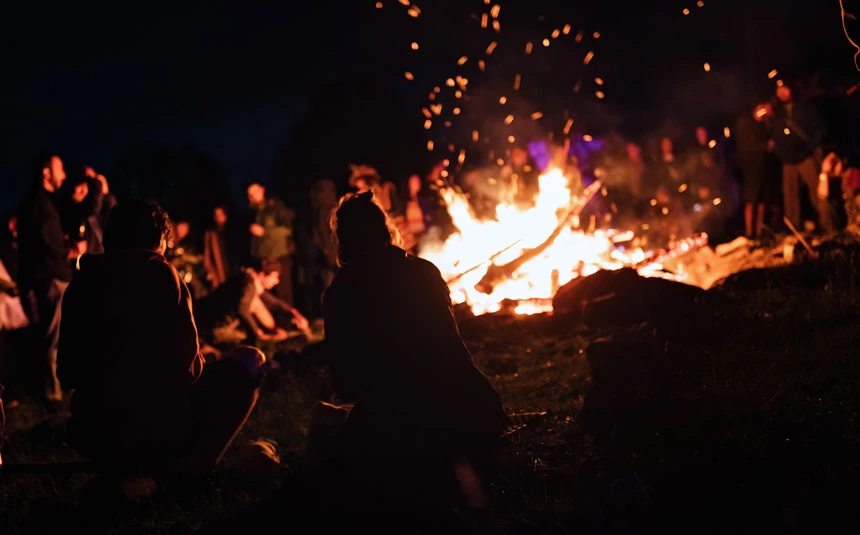Have you ever wondered how to keep a campfire burning all night?
Although it’s somewhat dangerous to keep a campfire lit all night, especially while you are at sleep, there are times when you need to do so. After all, not all the places in the world are the safest for camping, and that little flame light from your campfire may save you from some hungry hunks!
Therefore, we have brought you the safest guide to maintaining a burning campfire. This article will not only elaborate on what you should do to keep the fire going all night but give you tips on its safety precautions.
Let’s get started!
Table of Contents
How to Keep a Campfire Burning All Night
Burning a long-lasting campfire at night involves several factors. Among these, storing up fuel resources and providing your campfire with enough oxygen and heat are essential.
Whereas fuel is the critical component that keeps the fire alive, oxygen and heat prevent your fire from burning out. And you must ensure these three components are constantly provided to your campfire to keep its flames strong.
Here are seven foolproof tips for keeping your campfire going all night!
1. The Half-Inch Rule
The half-inch rule (½ Inch Rule) is a good rule of thumb for every campfire to keep burning till the time you expect it to. This generally indicates the amount of wood you will need to last a long-burning fire.
Although the entire thing might vary depending on the type of wood you use, how much heat the coals can generate, and whether the campfire gets better access to oxygen.
The rule is,
It will take roughly an hour to burn through a half-inch of wood.
But remember, if you use larger pieces of wood that are thicker than 6 inches, the burning time of the wood will change to an inch per hour.
This is an effective formula to calculate the amount of fuel one might need to keep the fire burning through the night.
2. Use Slow Burning Pieces of Wood
Oftentimes, people go with a pile of kindling, dry wood shavings, or any other bundles of firewood that are prone to burning fast. But in terms of keeping a campfire alive for a longer period, it’s crucial to go with slower burning pieces of wood.
Slow-burning woods are usually not the quickest to burn through, even not the roarest that can generate higher flames and brighten up the atmosphere, but they are a good choice for a long-night campfire. After all, your intention is to keep the campfire going with a slow burn and keep you warm.
Here are some of the popular choices of slow-burning woods that you can pick from,
- Ash
- Oak
- Maple
- Cherry
- Birch
- Beech
At first, you can start with kindling, newspaper, or even wood shavings to start up a campfire. They are easy to lighten up and create a good bed of coal for a long-lasting fire.
3. Include Lots of Rocks

Although it sounds confusing as to why add rocks if they are not supposed to burn at all, they are pretty good heat conductors.
When you add rocks to your camp firepit, they will generally hold the heat and keep the energy level efficient for the fire to burn long enough.
The rocks do not pose any safety hazards if used properly. Place a couple of large, flat rocks in the middle of the fire. Then add rocks that are slightly smaller or larger, as well as a variety of shapes.
Later if you want can use those hot rocks inside your tent to increase the temperature of your tent during a winter night.
4. Cover the Woods with Ash
According to some fire experts, if you cover the burning logs with ash, you prevent them from releasing their heat. This way, they reach their optimal temperature faster, producing a higher flame.
This is an effective tip that many people think is counterintuitive to long-lasting campfires. But, in the long haul, this can lead to a much slower and more constant burn.
However, be mindful of how you are covering the woods. You may need to cover it well but not entirely as then it will block the constant airflow from flowing within it.
5. Self-Feeding Fire Design

Self-feeding fire design is another effective technique to keep campfires burning all night. This entirely relies on on-ramps and fuel.
So first, you will need to get a fire pit going. Then, stack your wood on the ramps. As the fire burns down your wood, the ash will fall down the ramp, and another wooden figure will slide its way into the firepit.
Although this is somewhat a tricky technique that may consume a lot of your time, it will be worth it once you finish setting up the campfire.
However, it is really important to set up such a campfire carefully. Make sure it is on a flat, level surface. You should also not set this too close to trees and ensure the fire pit is a safe distance from any flammable objects.
6. Go with a Tipi Design

You can also try out a tipi design if the self-feeding fire design seems too hazardous for you. This design is almost set up like a cone shape using a few pieces of dry wood.
This design allows air to circulate through the center of the coals, burning the bottom parts while the wood burns upward. This promotes a constant flow of warm air within the fire pit.
The tipi style works best for starting fires for an overnight campfire because it’s easy to find kindling. The box method works just as well, although it’s a little more difficult to get started with.
7. Keep Constant Air Flow
When trying to build fires, people sometimes forget that one of the most important elements is oxygen.
Therefore, you must set your campfire in a way that will ensure proper ventilation. Here are some tips on how to keep the fire going with adequate airflow:
- Make every effort to guarantee that oxygen reaches the fire’s source.
- To make the ring of your fire, use big rocks.
- Allow enough space between them for air to circulate during the night.
- Dig trenches around the fire pit to ensure airflow.
Importance of Keeping a Campfire Burn All Night
Here are three reasons you should never let your campfire die out at night.
- You might need It for warmth. If the temperature drops unexpectedly or you get caught in a storm, having a campfire going will be a lifesaver. Even if you have a sleeping bag, having a fire will help you stay warm and dry.
- It could help signal for help. If you get lost or hurt while camping, having a fire burning will help rescuers find you. Make sure to build your fire in an open area, visible from afar.
- It will keep away predators. If any predators are lurking around your campsite, they will be less likely to approach seeing the burning flames.
Key Takeaway
Knowing how to keep a campfire burning all night is crucial for every camper. It isn’t only meant for fun but to help the campers stay safe in many circumstances. So, being one of the campers yourself, you should also be mindful of mastering this challenging task.
In this guideline, we have already mentioned the proper techniques for maintaining a long-lasting fire. You may follow the procedure and ensure your safety as well as a better camping experience.
Besides, by keeping your campfire lit, you’ll be able to stay warm and dry and even cook food if necessary. So next time you’re out camping, make sure you know how to make a campfire last longer.




